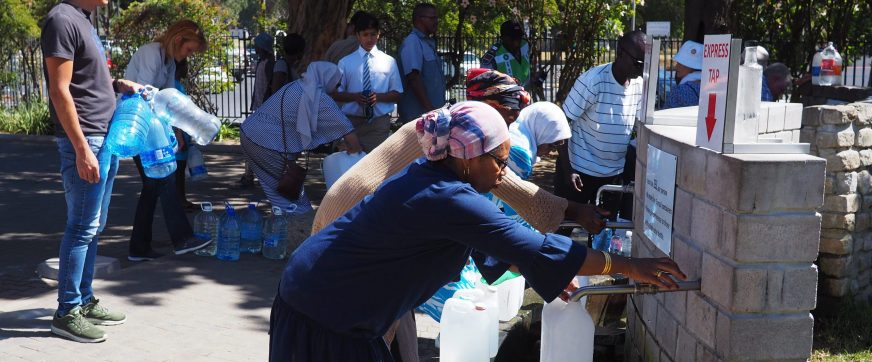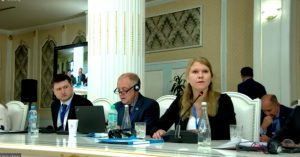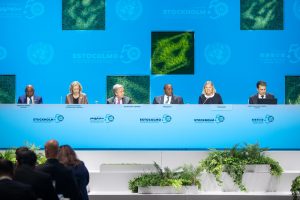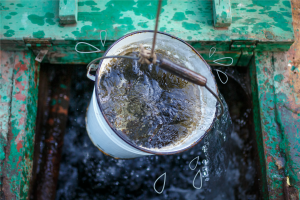- SIWI – Leading expert in water governance
- /
- Latest
- /
- How Cape Town saved itself from Day Zero
How Cape Town saved itself from Day Zero
 The water crisis in Cape Town, South Africa has sent people to harvest water from natural springs daily.
The water crisis in Cape Town, South Africa has sent people to harvest water from natural springs daily. Transparency, information and behavioural change saved Cape Town from Day Zero – the day the city was destined to run dry – in 2018. "The drought has taught us the importance of taking the residents along with us,” says Xanthea Limberg, Mayoral Committee Member for Water and Waste Services at City Of Cape Town.
The water collection point in Newlands, in the southern suburbs of Cape Town, has been upgraded to a permanent stand, with 16 taps to facilitate the tapping of spring water that originates from the Table Mountain aquifers.
“When the city restricted water use to 50 litres per person per day in 2018, that’s when I started to come here. We just had to find additional water for our family,” says Mervin Johnson who is retired and comes to the spring on a regular basis.
More than a year later, the water restrictions stand at 105 litres per person per day but Johnson’s family has more or less kept their water-wise habits.
“We used to take baths, but since the days of the drought everyone in my family showers and we collect all the grey water in the household to use in our garden. It brings down the water bill,” he says.
The drought alarm first sounded during the summer of 2017. In 2018, Day Zero, the day Cape Town was going to turn off the taps, loomed over the city. In an unprecedented effort by all sectors of society, water consumption was more than halved and Day Zero was called off. In an unprecedented effort by all sectors of society, water consumption was more than halved. When the winter rains finally arrived and the dams started to fill up, Day Zero could be called off.
In November 2019, the low consumption figures started to inch up slightly but they still stand at about 650 million litres of water per day, in comparison to the 1,200 million litres to 1,500 million litres of water per day that the City used to consume prior to the drought during the peak summer months.
Wilmarie January is also a regular at the spring.
“I have continued to catch the shower water to use it for flushing the toilet, and when I run my washing machine I add the water manually. That saves a lot of water,” she says.
Historically, water supply in Cape Town, the second largest city in South Africa, has been dependent on the winter rains. But after two consecutive dry winters, the drought was a fact. The response from the city of Cape Town was multipronged and ranged from consumer restrictions and tariff hikes to pressure management and emergency water-augmentation schemes.
“We ultimately overcame the drought through demand management. Every sector of society was involved and it was really that collective action that reduced our consumption. Cape Town’s ability to reduce its demand over such a short period of time is something that hasn’t been done anywhere else in the world,” says Xanthea Limberg, Mayoral Committee Member for Water and Waste Services at City Of Cape Town.
She believes that information and transparency were key factors to get the residents on board. The city published an online guide with water-saving tips for households, and a water dashboard showing the standing water consumption and dam levels was updated weekly.
“We launched a ‘watermap’ on an open platform where each household was given a certain coloured dot, depending on their water consumption. People were able to see who was saving water and who was not. Peer pressure is one of the most effective tools to actually drive behavioural change. The water consumption decreased after the launch of the map,” Limberg says.
The most important lesson learnt from the crisis, she thinks, is the importance of taking the residents along on the journey and to form partnerships with all sectors of society.
“I think everyone has dramatically shifted their relationship with water and I think there is still a great pride in people who can show a low level of consumption. The drought made people realize how much water we used to waste,” says Limberg.
At the Environmental-Economics Policy Research Unit (EPRU), University of Cape Town, researcher Johanna Brühl, together with professor Martine Visser, has been analyzing the effects of the different interventions put in place during the drought. It’s difficult to pinpoint what exact intervention had what effect as they were implemented at the same time or shortly after one another.
“What we do see, however, is a big behaviour change when the city changed the communication strategy and became more transparent around water supply and availability,” says Brühl.
Another significant drop came when the city informed high-volume consumers that a water-management device would be installed on their properties to control their consumption. The city also included general information about the drought, as well as tips on how to save water, in the letter.
“The letter pointed out that these households used excessive amounts of water compared to others, and it was quite effective. Their water consumption dropped. We know from previous studies that social comparisons and social recognition works surprisingly well, especially for high-income households. Those findings underpinned the idea behind the water map,” says Brühl.
All results are not out as yet, but generally the conclusion is that high-income households were more motivated to reduce their consumption through social pressure and low-income households by different pricing, concludes Brühl.
To draw attention to the lessons learnt, the W12 Congress invited some 20 cities predicted to face a Day Zero scenario to Cape Town at the end of January 2020.
“Every city that has dealt with a drought has done so in different ways because all situations are unique. Our aim is to create the framework for a Major City Best Practice Water Protocol, an evolving document to facilitate progress on sustainable water access,” says Rene Frank, Chairman of W12.
The Congress was initiated by SOS, a non-profit organization focusing on water and sanitation in schools, in partnership with The Institute of Ecological Civilization and the University of the Western Cape.
“We take a holistic approach on the issue and look at water from six different areas: political, natural and technical sciences, social society, economics and politics,” says Shelley Humphreys, Executive Director of SOS.
When talking about climate change and water-related issues, it is often done in theoretical terms, Frank points out. In the case of Cape Town, theories became reality.
Coining the expression Day Zero made people aware of the severity of the situation and the general public realized that if water consumption was not reduced, they would have to spend their days in lines to collect water.
“What happened in Cape Town was for real and we have a responsibility to share what we’ve learnt and tell the story of the sacrifices people had to make,” says Frank.
“It’s all about behavioural change, and I think the drought changed the way we think about water. Who knew how many litres of water a dishwasher uses? Or a bath? We never quantified it before but when all you have is 50 litres of water per day and you know a bath takes 200 litres, you just can’t have a bath,” Humphrey says.
Many people who could afford it invested in rainwater tanks during the drought to capture the little rainwater that fell. All the tanks are still in use.
“You can see it on your water bill after a good rain, then the consumption is down because all the rainwater captured is being utilized,” says Frank, adding that it is not always as easy for residents in poorer communities to save water.
“Traditionally, the township dwellers are very low water users, but they often lack an alternative water source, and thus the residents have only drinking water to use. Therefore, we installed water tanks in some of the settlements to assist micro businesses such as car washes and micro gardens, so that they could continue their businesses without putting further strain on the drinking water.”
On a much larger scale, one of the biggest corporations in South Africa, Old Mutual, responded to the crisis by building its own water filtration system, which has enabled the company to go off the water grid. With approximately 9,000 employees working at its campus in Cape Town, the Old Mutual office is like a small town.
“When water restrictions were introduced, we had to ask ourselves: how would we operate if the taps were turned off? That’s how it started,” says Zoë Rushin, Facilities Manager at Old Mutual.
Building the wastewater-to-drinking-water filtration system took less than a year and even before it was in use, people on the campus had changed their behaviour towards reducing the monthly water consumption by 30 per cent. Communication and information to the staff have been paramount and the system has been fine-tuned to meet all the required standards.
“It tastes better than municipal water,” Rushin says, filling a glass of water from one of the stands in the reception area.
Approximately 75 per cent of all the water used on the campus is reused and treated, the rest is lost in the system. To top up, Old Mutual adds wastewater from the municipality that is treated on-site.
There have been some issues with employees not fully buying into the concept of turning wastewater into drinking water, admits Rushin. But the company is busy conducting employee education to make everyone comfortable to use the water.
“It’s all about changing the mindset and understanding that water is a reusable, not a renewable, commodity.”
This text was first published in WaterFront 1/2020 – read the full magazine here
Text: Görrel Espelund
Photo: Eric Miller





